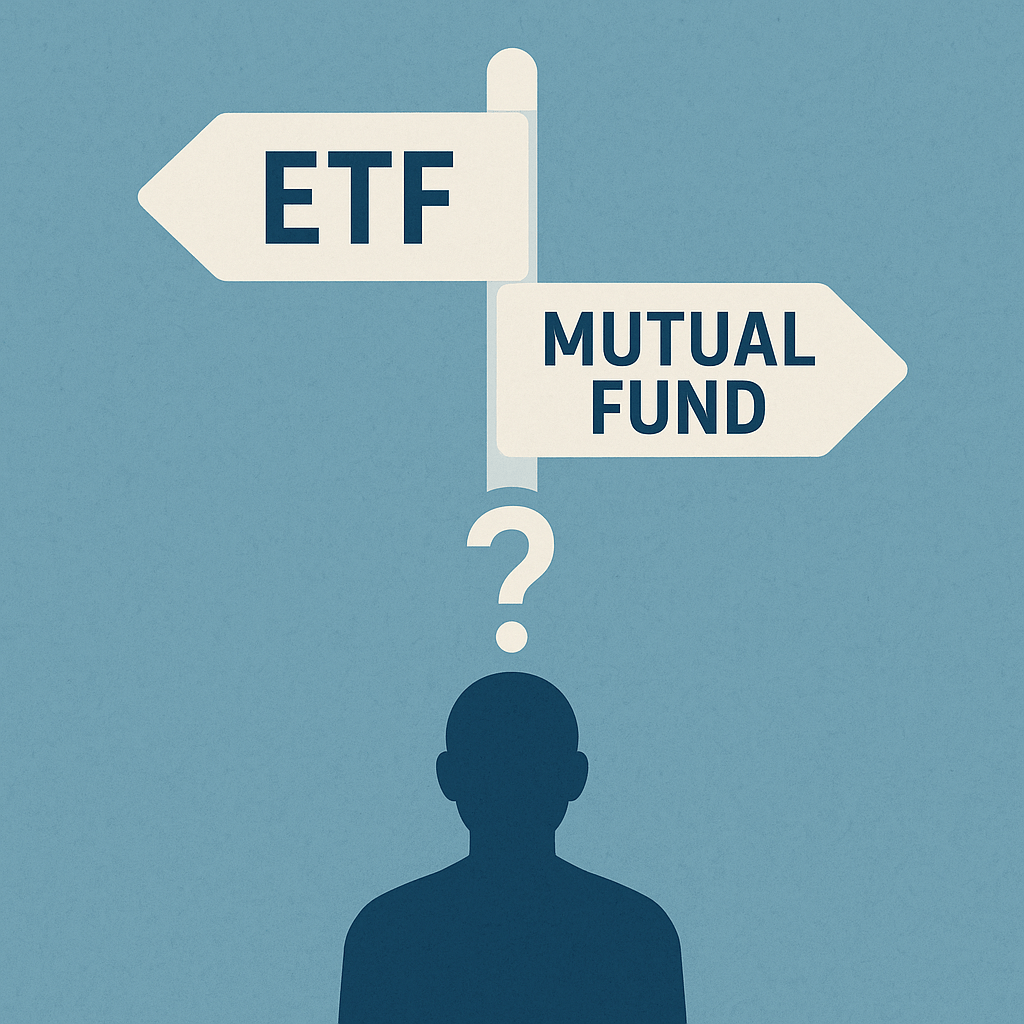When it comes to investing, the sheer number of options can be overwhelming — especially for those trying to build a plan that balances growth, efficiency, and peace of mind. Two of the most common investment vehicles you’ll encounter are Exchange-Traded Funds (ETFs) and Mutual Funds. Both offer diversification, both can be professionally managed, and both serve long-term investors — but how they operate under the hood is very different.
Let’s break them down.

What Are Mutual Funds?
Mutual funds are investment vehicles that pool money from a large group of investors to purchase a diversified portfolio of stocks, bonds, or other assets. These funds are typically actively managed, meaning a professional fund manager makes decisions about how to allocate and adjust the portfolio.
One key feature: you can only trade mutual funds once per day, after the market closes. The price you get is based on the fund’s Net Asset Value (NAV) at the end of the trading day.
While mutual funds often provide the benefit of active management, they also tend to come with higher fees, including potential sales loads and ongoing expense ratios. That professional management isn’t free — and that’s something investors should weigh carefully.
What Are ETFs?
ETFs, or exchange-traded funds, function similarly to mutual funds in that they offer a basket of diversified investments. However, ETFs are typically passively managed and built to track the performance of an index — like the S&P 500.
Here’s the big difference: ETFs trade like stocks, meaning you can buy and sell them throughout the day. This gives you more flexibility and the ability to respond to market changes in real time.
Another advantage? Lower fees. Because most ETFs are not actively managed, they generally have lower expense ratios than mutual funds. Plus, ETFs are considered more tax efficient, thanks to their unique “in-kind” redemption structure which helps avoid triggering capital gains taxes.
Key Differences to Know
| Feature | Mutual Funds | ETFs |
| Trading | End of day (NAV) | Intraday (stock market) |
| Management | Typically active | Typically passive |
| Fees | Higher | Lower |
| Tax Efficiency | Lower | Higher |
| Investment Minimum | Often $1,000+ | As low as one share |
Which One Should You Choose?
Ultimately, the right choice between ETFs and mutual funds depends less on the investments themselves — and more on you.
Ask yourself:
- How much trading flexibility do I need?
- Am I looking for low-cost, passive investing — or do I value professional active management?
- How important is tax efficiency to my broader financial plan?
- Do I prefer a hands-off approach (automatic investment plans) or the ability to adjust on my own?
It’s not uncommon for well-diversified portfolios to use both ETFs and mutual funds. For instance, someone might use low-cost ETFs for core market exposure (like the S&P 500), but complement it with a few actively managed mutual funds targeting specific niches like emerging markets or alternative assets.
The key isn’t picking a perfect product — it’s picking the right combination that fits your strategy, risk tolerance, and goals.
Future Considerations
While ETFs have exploded in popularity, mutual funds still represent a major share of the investment landscape. Looking ahead, several trends could shape the decision further:
- Rise of Active ETFs: New ETFs offering active management are bridging the gap between traditional mutual funds and passive investing.
- Fee Compression: Continued competition could drive expense ratios even lower, making cost differences between the two less dramatic over time.
- More Conversions: Some mutual fund companies are shifting existing funds into ETFs to meet investor demand for flexibility and tax advantages.
The investing world keeps evolving — but the basics of understanding how your investments work, and why they fit your plan, will always be a timeless advantage.
The Big Picture
ETFs and mutual funds are both powerful tools — but like any tool, they need to be used the right way.
Choosing between them comes down to your financial goals, your investment style, and how much control you want over your portfolio.
As always, if you’re unsure where to start or how these pieces fit into your broader plan, consulting with a financial advisor can help you build a strategy tailored to your needs — one built for confidence, not confusion.
Preparation, not panic. That’s how you build confidence in your financial future.
References:
Investopedia. (2014). Key Differences Between ETFs and Mutual Funds.
Investopedia
Charles Schwab. (n.d.). Mutual Funds vs. ETFs.
Schwab
University of Illinois System. (n.d.). ETFs vs. Mutual Funds.
U of I Blog
Investopedia. (2024). ETFs and Your Retirement Plans.
Investopedia
Financial Times. (2024). JPMorgan Converts $7bn of Mutual Funds into ETFs.
Financial Times
Business Insider. (2024). Why JPMorgan Thinks ETFs Have the Edge Over Mutual Funds.
Business Insider
We are an independent firm helping individuals create retirement strategies using a variety of investment and insurance products to custom suit their needs and objectives. This material is intended to provide general information to help you understand basic retirement income strategies and should not be construed as financial advice. Investing involves risk, including the potential loss of principal. No investment strategy can guarantee a profit or protect against loss in periods of declining values.